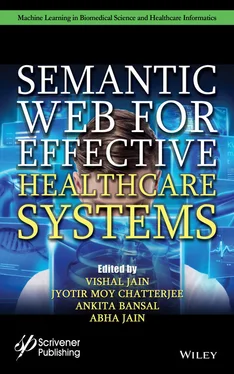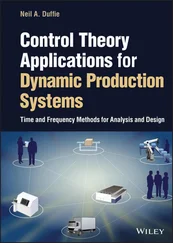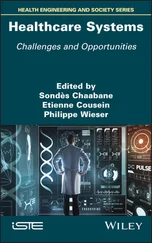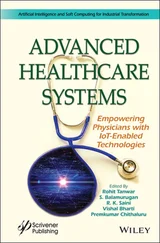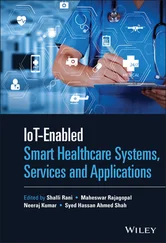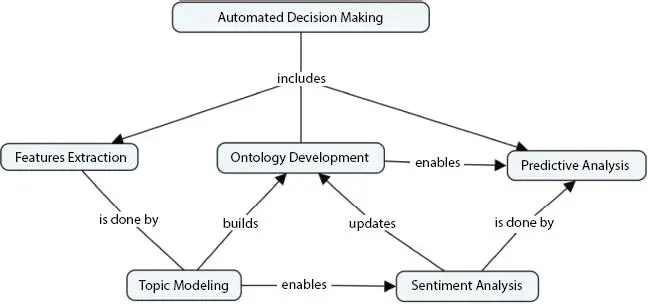
Figure 1.2 User-generated content analysis (UCA) model.
1.1.1 Ontology-Based Information Extraction
Ontology describes a domain of classes. It is defined as a conceptual model of knowledge representation. The concepts of the domain (classes), their attributes, their properties and their relationships are well described by the Ontology model. It also explains the meanings of the terms applicable to the domain. Ontology is one of the key components of semantic web technology. The semantic web technologies like Ontology, RDF and Sparql are used in describing different words and their dependencies by modeling the textual data. Components of Ontology include:
• Concepts are also known as Classes. It is a unit of knowledge, shared among identified group of persons for the concept’s domain. There exists relationship among concepts.
• Instances are individuals of concepts. They represent specific elements attached to the domain ontology. Instances are the “thing” represented by a concept.
Information Extraction (IE) and Ontology are related with one another like: Ontology is used in information extraction as part of understanding process of the domain; on the other hand, IE is used to design and enrich Ontology [7]. Common vocabulary and shared understanding among different people are enabled by Ontology. The contextual representation of data semantics is well described by the Ontology [8]. The UML diagrams along with Ontology support the biologists by classifying the entities and interactions between proteins and genes [9]. The terms (vocabularies) and the concepts (classes) in the source Ontology are used in term matching, thereby used in tagging the text documents. Thus the Ontology and their specifications are used in the information extraction process.
1.1.2 Ontology-Based Knowledge Representation
Knowledge is data that represents the outcome of computer-based cognitive processes such as perception, learning, association, and reasoning, or the translation of knowledge acquired by human [10]. It is the language by which human express their understanding about the concept. The concepts and the instances of a particular domain are expressed in the knowledge base also referred as the semantic knowledge dictionary. It is one of the most important techniques to represent the knowledge for a domain. Domain Ontology is developed to formally define the concepts, relationships, and rules so as to include the semantic content of the domain. The semantic approach uses the concepts in the documents to establish the contextual relationship rather than the terms. Issues like synonymy and polysemy may not be resolved if terms are used as indices while modelling the text documents. Various semantic-based information extraction approaches like Latent Semantic Indexing [11] and Latent Dirichlet Allocation [12, 13] techniques are used for building the relationship among the indexed terms, so as to represent the contexts between the concepts. This chapter focuses on developing domain Ontology to represent the features and their related terms mentioned in the product/service reviews generated in social media web sites.
Ontology facilitates the shared understanding among the people by formalizing the conceptualization of a specific domain. The contextual representation of data semantics is well described by the Ontology [8]. Ontology defines concepts (domain) by using the common vocabulary and describes attributes, behavior, relationships and constraints. The UML diagrams along with The interactions between proteins and genes are well explained by Ontology representation which would support the biologists for classification [9]. Reviews on hotels and movies are classified using the rule-based systems and Ontology [14–16]. Document annotation and rules were used to create knowledge base of web documents from the extraction of semantic data like named entities [14, 17, 18]. Ontology learning and RDF repositories were used for building the knowledge and information management which in turn enabled the automatic annotation and retrieval of documents [19]. Wordnet Ontology was used in extracting the sentiments based on lexicon dictionaries [20, 21].
Information extraction process uses Ontology for understanding the domain and for extracting the relevant information. Its complexity is reduced as it is domain specific. IE techniques are then used for populating and enhancing the Ontology. These Ontologies can be enriched from the useful sources of knowledge [7]. SVM classification along with SentiWordNet enabled the building of sentiment dictionary for positive and negative categorization of text documents [23]. Opinion extraction techniques along with entropy-based classification techniques are used for building structured Ontology for the datasets Digital Camera [24]. Classification of products and their attributes based on their hierarchy was done using the hierarchical learning sentiment ontology tree (HL-SOT) algorithm which in turn used for opinion mining of products and their features [25].
Knowledge base refers the dictionary for the vocabulary used to represent concepts of a specific domain. The Ontology provides the semantic knowledge for class instances like a dictionary. The meaning of the documents may be extracted using the semantic-based approach by establishing the suitable context within the document, instead of using terms present in the document. Related terms were extracted and categorized using the semantic-based approaches like LSI [11] and LDA [13] techniques. Ontology-based sentiment analysis model was developed for mining product features from customer reviews [1]. Ontology along with Genetic Algorithm, a hybrid-model, was used for automatic grouping of Chinese proposals into different clusters resulted in >90% F-measure value [26]. Sentiment lexicons of emotional categories were derived from the twitter posts of mobile products by using Ontology learning and the lexicon-based techniques [27]. Ontology and vector analysis method was used in feature selection and sentiment analysis of movie reviews [22]. Ontology-based sentiment analysis model along with rule-based classification was used in the postal services of United States and Canada [28]. Sentiment grabber model was developed using Ontology, probabilistic LDA and text annotations [13]. Hotel reviews were automatically classified by using SVM and fuzzy domain ontology [29].
Research on user-generated content was also focused on the lexicon-based or linguistic-based approach. Named entity recognition, feature extraction, reliability of content, language used are some of the challenges exist for text analysis. Information Retrieval (IR) techniques like Vector Space Modelling, Latent Semantic Indexing (LSI) and Latent Dirichlet Allocation (LDA) were used for transforming unstructured free text into structured format. Words which do not represent entities were removed from consumer product reviews by using PMI measure, to improve the precision of feature extraction method [30]. In the lexicon-based approach, positive and negative words were extracted from the opinions [31–34], and overall sentiment aggregation was determined for the documents. Words or phrases in the presence of conjuncts and connectives were considered to build word dependencies. Sentiment analysis was then done using Naive Bayes classification algorithm [31, 34]. Opinion observer was built using NLP techniques for detecting the polarity of opinions and by using the opinion aggregation function [35]. Automatic extraction of adjectives related to sentiments from blogs and reviews was proposed and used association rule mining for building the dictionary [32], which resulted in the accuracy of more than 70% for positive adjectives and more than 60% for negative adjectives. Similarly, sentiment dictionaries were created using naive Bayes algorithm and NLP techniques for developing opinion mining model for film reviews [36]. Poirier et al . concluded that machine learning algorithms were suitable for larger data set, whereas linguistic methods were suitable for smaller data set.
Читать дальше
